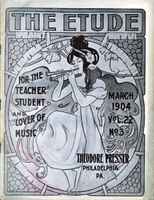How few students ever have an ambition to own a good bow. Of Stradivarius and Amati they dream for years, but for Tourte, Lupot, and other good bow makes they care little. This is one chief reason why they remain among that class of students who never really get along well—who never reach the profession. Their bow has no elasticity, and is either quite straight, or "has its back up," bending away from the hair. The strength of a bow depends upon its bend toward the hair as well as its wood and model.
No certain weight or length can be given; this is a matter depending on the violinist's arm and strength. One of the largest dealers in the country informs me that the call is for longer bows—over thirty inches. From twenty-eight inches or more is a proper length.
Ole Bull used a heavy bow, but all violinists have not the strength of the great Viking, who could throw the strongest frontiersman with neatness and dispatch. (This story is too well known to repeat here.) As to balance, I have two bows exactly twenty-nine and one-fourth inches long, and they balance at seven and one-half inches from the place where the thumb rests, or ten and three-eighths inches from the end. Near the tip the diameter should be three-sixteenths of an inch.
Some violinists actually believe they have a bow that bends neither to the right or left when tightened ready for playing. There are very few such bows. As a matter of information they should bend slightly to the left, to counteract the effect of playing. A dealer will take a crooked bow and, while you are looking at another, rub the "elbow" out in a few moments and return it to you as perfect. But I fear this letter is already too long.— Violet.



